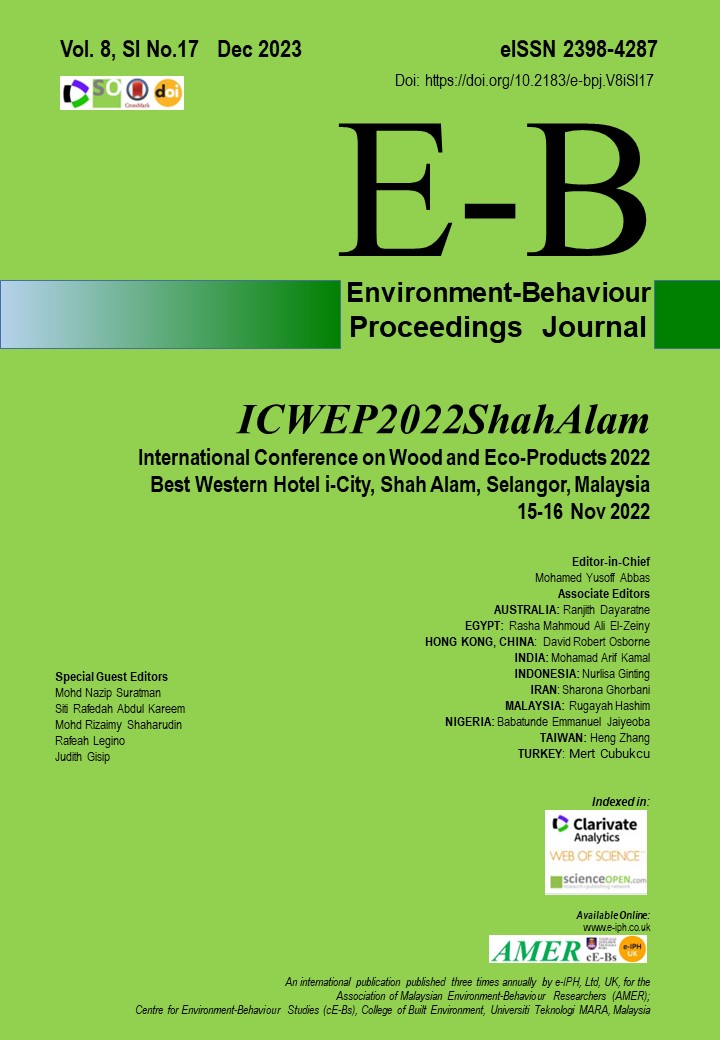Flexural and Flammability Characteristics of Woven Jute Fabric Reinforced Vinyl Ester Treated with Ammonium Polyphosphate
DOI:
https://doi.org/10.21834/e-bpj.v9iSI17.5421Keywords:
Jute, Composite, Vinyl Ester, Fire-retardantAbstract
The work aims to determine the optimum fire-retardant treatment for the jute/vinyl ester composites on the composites' flexural and flammability characteristics. Ammonium polyphosphate deposition in composite samples increased the thickness and weight, which led to an increase in their sample densities. The deposition of 10% ammonium polyphosphate (APP) resulted in the highest flexural strength. However, APP significantly increased the flexural modulus of all samples to the untreated sample. In terms of flammability properties, the deposition of APP increased composites' performance against fire. Incorporating 10% of APP provides good flexural and fire-retardancy properties for the woven jute/vinyl ester composites
References
Alongi, J., Carosio, F., & Malucelli, G. (2012). Influence of ammonium polyphosphate-/poly (acrylic acid)-based layer by layer architectures on the char formation in cotton, polyester and their blends. Polymer Degradation and Stability, 97(9), 1644-1653. DOI: https://doi.org/10.1016/j.polymdegradstab.2012.06.025
Alsubari, S., Zuhri, M., Sapuan, S., Ishak, M., Ilyas, R., & Asyraf, M. (2021). Potential of natural fiber reinforced polymer composites in sandwich structures: A review on its mechanical properties. Polymers, 13(3), 423. DOI: https://doi.org/10.3390/polym13030423
Arjmandi, R., Ismail, A., Hassan, A., & Bakar, A. A. (2017). Effects of ammonium polyphosphate content on mechanical, thermal and flammability properties of kenaf/polypropylene and rice husk/polypropylene composites. Construction and Building Materials, 152, 484-493. DOI: https://doi.org/10.1016/j.conbuildmat.2017.07.052
Bachtiar, E. V., Kurkowiak, K., Yan, L., Kasal, B., & Kolb, T. (2019). Thermal stability, fire performance, and mechanical properties of natural fibre fabric-reinforced polymer composites with different fire retardants. Polymers, 11(4), 699. DOI: https://doi.org/10.3390/polym11040699
Bakar, M. A., Ishak, Z. M., Taib, R. M., Rozman, H., & Jani, S. M. (2010). Flammability and mechanical properties of wood flour‐filled polypropylene composites. Journal of Applied Polymer Science, 116(5), 2714-2722. DOI: https://doi.org/10.1002/app.31791
Boccarusso, L., Carrino, L., Durante, M., Formisano, A., Langella, A., & Minutolo, F. M. C. (2016). Hemp fabric/epoxy composites manufactured by infusion process: Improvement of fire properties promoted by ammonium polyphosphate. Composites Part B: Engineering, 89, 117-126. DOI: https://doi.org/10.1016/j.compositesb.2015.10.045
Chapple, S., & Anandjiwala, R. (2010). Flammability of natural fiber-reinforced composites and strategies for fire retardancy: a review. Journal of Thermoplastic Composite Materials, 23(6), 871-893. DOI: https://doi.org/10.1177/0892705709356338
Gopinath, A., Kumar, M. S., & Elayaperumal, A. (2014). Experimental investigations on mechanical properties of jute fiber reinforced composites with polyester and epoxy resin matrices. Procedia Engineering, 97, 2052-2063. DOI: https://doi.org/10.1016/j.proeng.2014.12.448
Horrocks, A. R. (2011). Flame retardant challenges for textiles and fibres: New chemistry versus innovatory solutions. Polymer Degradation and Stability, 96(3), 377-392. DOI: https://doi.org/10.1016/j.polymdegradstab.2010.03.036
Jariwala, H., & Jain, P. (2019). A review on mechanical behavior of natural fiber reinforced polymer composites and its applications. Journal of Reinforced Plastics and Composites, 38(10), 441-453. DOI: https://doi.org/10.1177/0731684419828524
Kandola, B. K., Mistik, S., Pornwannachai, W., & Anand, S. (2018). Natural fibre-reinforced thermoplastic composites from woven-nonwoven textile preforms: Mechanical and fire performance study. Composites Part B: Engineering, 153, 456-464. DOI: https://doi.org/10.1016/j.compositesb.2018.09.013
Kim, N., Dutta, S., & Bhattacharyya, D. (2018). A review of flammability of natural fibre reinforced polymeric composites. Composites Science and Technology, 162, 64-78. DOI: https://doi.org/10.1016/j.compscitech.2018.04.016
Misnon, M. I., Islam, M. M., Epaarachchi, J. A., & Lau, K.-t. (2014). Potentiality of utilising natural textile materials for engineering composites applications. Materials & Design, 59(0), 359-368. doi:http://dx.doi.org/10.1016/j.matdes.2014.03.022 DOI: https://doi.org/10.1016/j.matdes.2014.03.022
Sain, M., Park, S., Suhara, F., & Law, S. (2004). Flame retardant and mechanical properties of natural fibre–PP composites containing magnesium hydroxide. Polymer Degradation and Stability, 83(2), 363-367. DOI: https://doi.org/10.1016/S0141-3910(03)00280-5
Shukor, F., Hassan, A., Islam, M. S., Mokhtar, M., & Hasan, M. (2014). Effect of ammonium polyphosphate on flame retardancy, thermal stability and mechanical properties of alkali treated kenaf fiber filled PLA biocomposites. Materials & Design (1980-2015), 54, 425-429. DOI: https://doi.org/10.1016/j.matdes.2013.07.095
Xu, J., Gao, M., Guo, H., Liu, X., Li, Z., Wang, H., & Tian, C. (2002). Study on the thermal degradation of cellulosic fibers treated with flame retardants. Journal of Fire Sciences, 20(3), 227-235. DOI: https://doi.org/10.1177/0734904102020003905
Zhang, Z. X., Zhang, J., Lu, B.-X., Xin, Z. X., Kang, C. K., & Kim, J. K. (2012). Effect of flame retardants on mechanical properties, flammability and foamability of PP/wood–fiber composites. Composites Part B: Engineering, 43(2), 150-158. DOI: https://doi.org/10.1016/j.compositesb.2011.06.020
Downloads
Published
How to Cite
Issue
Section
License
Copyright (c) 2024 Mohd Iqbal Misnon, Khairul Naseem Mohd Rodzi, Jauhar Fajrin, Md Mainul Islam

This work is licensed under a Creative Commons Attribution-NonCommercial-NoDerivatives 4.0 International License.





